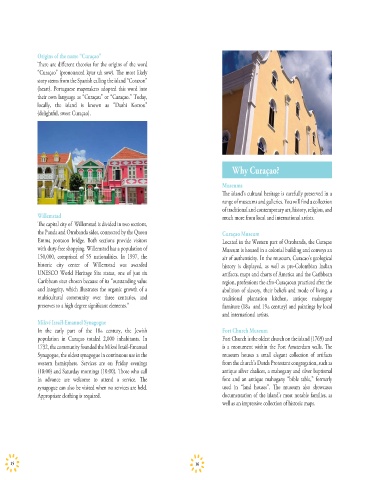Page 726 - Visitor Guides
P. 726
Origins of the name “Curaçao”
ere are different theories for the origins of the word
“Curaçao” (pronounced kyur uh sow). e most likely
story stems from the Spanish calling the island “Corazon”
(heart). Portuguese mapmakers adopted this word into
their own language as “Curaçau” or “Curaçao.” Today,
locally, the island is known as “Dushi Korsou”
(delightful, sweet Curaçao).
Kas di Pal’i Maishi
Kas di Pal’i Maishi is a traditional adobe house with a
latched roof built 130 years ago. It illustrates the way the
Why Curaçao? Afro-Curaçaoan rural population of Curaçao lived up to
1950. e method of construction dates back to before
Museums the year 1700 and coincides with the arrival of the
e island’s cultural heritage is carefully preserved in a enslaved Africans. Inside is a small museum with typical
range of museums and galleries. You will find a collection household artifacts from the past. Local food is served at
of traditional and contemporary art, history, religion, and lunchtime in the backyard.
Willemstad much more from local and international artists.
e capital city of Willemstad is divided in two sections, Kurá Hulanda Museum
the Punda and Otrobanda sides, connected by the Queen Curaçao Museum e forced relocation of Africans to the Americas and the
Emma pontoon bridge. Both sections provide visitors Located in the Western part of Otrobanda, the Curaçao Caribbean by Europeans from the 17 to the 19
th
th
with duty-free shopping. Willemstad has a population of Museum is housed in a colonial building and conveys an centuries changed the face of the world. Museum Kura
150,000, comprised of 55 nationalities. In 1997, the air of authenticity. In the museum, Curacao’s geological Hulanda is situated at the city-center harbor of
historic city center of Willemstad was awarded history is displayed, as well as pre-Colombian Indian Willemstad, where Dutch entrepreneurs once traded and
UNESCO World Heritage Site status, one of just six artifacts, maps and charts of America and the Caribbean shipped enslaved Africans along with other “commercial
Caribbean sites chosen because of its “outstanding value region, professions the afro-Curaçaoan practiced after the goods.” is museum impressively exhibits the
and integrity, which illustrates the organic growth of a abolition of slavery, their beliefs and mode of living, a Trans-Atlantic Slave Trade in its totality, from slave
multicultural community over three centuries, and traditional plantation kitchen, antique mahogany capture in Africa through the Middle Passage and the
preserves to a high degree significant elements.” furniture (18th and 19th century) and paintings by local relocation in the New World. e museum Kura
and international artists. Hulanda reveals how African and other diverse cultural
Mikvé Israël-Emanuel Synagogue heritages have influenced modern society.
In the early part of the 18th century, the Jewish Fort Church Museum
population in Curaçao totaled 2,000 inhabitants. In Fort Church is the oldest church on the island (1769) and Tele Museum
1732, the community founded the Mikvé Israël-Emanuel is a monument within the Fort Amsterdam walls. e is small museum is located in one of the most
Synagogue, the oldest synagogue in continuous use in the museum houses a small elegant collection of artifacts remarkable, buildings in the heart of Punda. e
western hemisphere. Services are on Friday evenings from the church’s Dutch Protestant congregation, such as permanent exhibition gives an overview of the
(18:00) and Saturday mornings (10:00). ose who call antique silver chalices, a mahogany and silver baptismal developments of telecommunication in Curaçao, from
in advance are welcome to attend a service. e font and an antique mahogany “bible table,” formerly the introduction of the telephone in the 1880’s to the
th
synagogue can also be visited when no services are held. used in “land houses”. e museum also showcases late 20 century inventions of fiber optic cables,
Appropriate clothing is required. documentation of the island’s most notable families, as computerization and tele-conferencing. e museum is
well as an impressive collection of historic maps. owned and operated by the island’s telecommunications
company, UTS.
15 16 17

